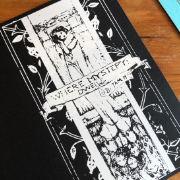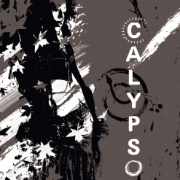How I Write a Lot

filed under writing on 24 Dec 2024
tagged writing and craft
So… up front, this may not work for you. I am as prolific as I am for a lot of reasons, some of them very personal. Years of practice at producing passable text on demand (play by post), for example. And I find it more enjoyable to write forward (and the other phases of writing) than do almost anything else.
I’d been compiling notes on my working process and what motivates me for a month or two, narrowing in on a model for it (ttrpg designer brain), when a friend shared this link with me: how I went from writing 2000k a day to 10000k. This article pretty much sums it up, with lots of good examples, but I have some refinements for myself, based on my experiments.
First, my goals are a lot more modest; I want to write 1k quality words a day, consistently, every day, with a goal of 70k (from “open” to “the end”) in 70 to 90 days. That’s a barebones rough draft in three months; that’s doable. And it’s a sufficient word count for most adult genres so I feel like I’ve “done it” even if the revisions are still looming.
So, first step; I set a clear, achievable goal. Set the bar low; you can always revise up— I went from a goal of 1k at day to a goal of 3k once I knew I could do it and maintain the quality that keeps me motivated. I’m also fine if I only hit 1k per active project in a given day. That’s still meeting my 70k in 70 days goal. I also limit myself to no more than two active projects at a time (which frankly so far is my biggest failing).
I suspect that this count will go up as context (what has been established so far fictionally) builds, both across a novel and across a series. My experience so far has been that the last few chapters just pour out.
Here are my notes, shaped by experience and the article above. Merry Christmas!
-
Prep (“knowledge”). For me that’s a strong narrative structure, probably custom, that feels “right” for the work and has phases with page counts. One that has emotional intensity. The classic example (though I think it’s better suited to Hollywood than a novel) is Save the Cat. Also characters who have a defining and emotional event in their past and a want (an overt goal they think will fix their lives or at least keep them going) that motivates them now. They might also have a need, a thing that will really fix their problems (to paraphase from Save the Cat). And a set of scenes I really want to see, derived from those characters, tucked into the narrative structure.
I also like to have a short bulleted list of “truths” I need to demonstrate for a given scene; “show he breaks things when he’s mad” or “explain how minor magic works” gives me something to write to, even if the context (everything that has happened up until now) of the scene has shifted away from how I originally expected it to be when we got to this part.
I need more of this than I think I do. You can deviate from it, updating later scenes to adjust. You can discard it entirely. But you can’t be supported by it if it doesn’t exist at all.
Note, this doesn’t usually take more than a few days to a week to actually complete on paper, but the longer it percolates in my mind, the easier “enthusiasm” seems to be.
-
Discipline (“time”). I don’t track that much, just what information the Writing Goal plugin for Obsidian gives me; words written per day, per file and per project, and a project total. I only edit as much as I need to; this is a subjective measure, but doing less editing, right up to the point of being slightly annoyed about it, has helped me work faster. Years ago I’d usually do a full re-read from page one and edit up to my last writing point each session, and I was able to do a NaNoWriMo just fine that way. Now I use the model I honed in play-by-post; I edit each “chunk” (technical term) enough to follow the last smoothly, and I make sure the contents of a given file are coherent, and then I just keep going.
Knowing what you hit enter on will be read and responded to (the play-by-post model) is excellent training for not over-editing a rough draft; in writing you have the luxury of reaching back and refining, reworking, and adjusting for flow, but for me, pretending it’s one and done has been very helpful. I do a bit more editing between brain and fingers than I should for real speed but that helps me reach a “readable” level of quality I feel excited to revisit later in revisions.
-
Enthusiasm. Arguably the hard part for me, because of discipline issues. I find it easy to find the joy in any given scene, no matter how small, once I start typing. It’s just too easy to skip a whole scene with a placeholder for later, and then end up having nothing but those left to write! Or I’ll get lost in eking out a few hundred words polishing a scene I might not keep. Or veer off my scene structure entirely, and write a candy bar scene I haven’t yet written the proper context for, so it will be flabby, vague, and maybe even need to be discarded later. The other pillars have pitfalls but they seem so much more obvious. I just try to write as in order as much as possible, even if that’s just an empty file with a big commented out summary.
Oh, and if I feel sluggish or lost (not enough “prep”), I write a long comment at the top of each file, kind of how I’d describe the contents of this file that I’m about to write if I were just telling someone about it. It’s just for me so I’m very casual with it, but I’m never rude to myself. It also works as a good bridge if I absolutely need to skip ahead. Comments don’t count in Obsidian against my word totals, either.
So, anyway, those are my notes. Oh, and also, I try to remember it’s a process to refine and reflect on, not a done deal. I am always iterating, always cutting stuff that isn’t working for me, or trying new things in small doses.


